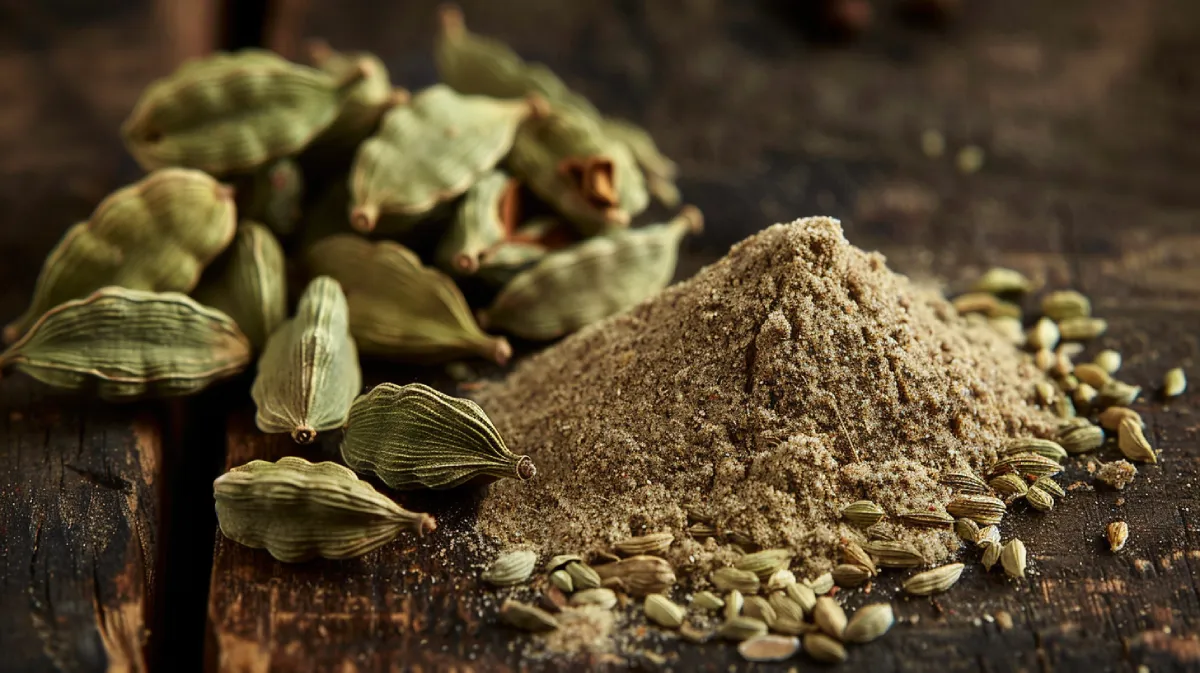Cardamom Pods Vs Ground: Maximizing Flavor
Cardamom pods and ground cardamom each bring unique benefits to your kitchen. Whole pods preserve flavor longer and emit a subtle aroma when simmered in dishes, making them perfect for slow-cooking soups and stews.
Ground cardamom offers intense, concentrated flavor, ideal for quick enhancements in baking or curries but loses potency quickly. Toasting and grinding fresh cardamom pods releases its full aromatic potential, ensuring vibrant flavors that exceed pre-ground spice.
The variety, from sweet green to smoky black pods, allows you to customize the spice to your dish. Explore these nuances to enhance your culinary experience.
Key Takeaways
- Whole cardamom pods retain freshness and essential oils longer than ground cardamom.
- Ground cardamom offers immediate and intense flavor but loses potency quickly after grinding.
- Toasted whole pods before grinding provide a fresher and more aromatic experience.
- Whole pods are ideal for slow infusion, while ground cardamom is suitable for quick flavor enhancement.
- Proper storage is crucial for maintaining ground cardamom’s freshness and potency.
About Cardamom
Cardamom, with its intriguing aroma and complex flavor, is a spice derived from the seed pods of plants in the ginger family. When you break open these spindle-shaped pods, you’ll find small, black seeds that are the true treasure.
These seeds can be used whole or ground, each form offering its unique contribution to your culinary creations.
As a spice, cardamom is renowned for adding depth and complexity to dishes, especially in Indian and Middle Eastern cuisine. The whole pods infuse dishes with a subtle, aromatic essence, while ground cardamom delivers a more intense burst of flavor.
However, one thing to keep in mind is that ground cardamom tends to lose its potency quickly. To maintain its vibrant flavor, it’s best to toast the green cardamom pods before grinding them.
Using cardamom in your cooking opens up a world of sensory experiences. Whether you’re enhancing a savory curry, spicing up a sweet dessert, or crafting an aromatic tea, this spice brings an unparalleled richness.
Varieties of Cardamom
As you explore the enchanting world of cardamom in your culinary adventures, you’ll discover several varieties, each bringing its own distinctive flavor profile to the table. One of the most popular types of cardamom is green cardamom pods. These vibrant, aromatic spice pods are known for their sweet, floral, and slightly spicy flavors, making them perfect for both savory and sweet dishes.
On the other hand, black cardamom offers a completely different experience. These larger, darker pods provide a smoky taste with earthy undertones and resinous notes, adding depth to hearty dishes like stews and curries.
Then there’s white cardamom, which is essentially bleached green cardamom. The whitening process results in a milder flavor profile, ideal for delicate dishes that require a subtle touch of spice without overpowering the other ingredients.
If you’re feeling adventurous, you might want to try Madagascar cardamom pods. These light green gems boast citrusy undertones, adding a zesty twist to your culinary creations.
Understanding the differences in pods vs ground forms of these types of cardamom can enhance your cooking, allowing you to harness the unique essence of each aromatic spice.
Whole Vs. Ground
When deciding between whole cardamom pods and ground cardamom, consider the flavor and potency differences, storage and shelf life, and recipe usability.
Whole pods infuse dishes with a robust, aromatic essence, while ground cardamom offers convenience but loses its potency quickly.
Each form has its unique advantages, making your choice dependent on the specific needs of your dish.
Flavor and Potency Difference
Whole cardamom pods pack a more essential and fresher flavor compared to their ground counterparts, thanks to the preservation of essential oils. When you use whole cardamom pods, the essential oils remain intact, delivering a robust and aromatic experience in your dishes. If you opt for ground cardamom instead, you’ll notice it tends to lose its flavor more quickly after grinding. This flavor and potency difference is critical in making your culinary creations truly stand out.
Whole pods are perfect for recipes that require a slow, steady infusion of flavor. You can toast the green pods before grinding them to enhance their flavor even further. However, ground cardamom offers the convenience of immediate use, though it may lack the same intensity and freshness as whole pods.
Here’s a quick comparison:
| Aspect | Whole Cardamom Pods | Ground Cardamom |
|---|---|---|
| Flavor Intensity | More essential and fresher | Less intense, diminishes quickly |
| Essential Oils | Preserved | Diminish after grinding |
| Usage | Ideal for infusing flavor slowly | Convenient for quick use, less potent |
Storage and Shelf Life
Storing cardamom properly can make a significant difference in how long its vibrant flavor and aroma last. Whole cardamom pods, when kept in an airtight container, can retain their freshness and potency for up to a year. The key is to store them in a cool, dark place, away from direct light and heat, guaranteeing that you experience their full aromatic potential for an extended period.
On the other hand, ground cardamom is much more delicate. Once you grind the pods, the spice starts to lose its flavor quickly, typically within a month. It’s essential to use ground cardamom promptly to capture its essence in your dishes. Keeping it in an airtight container can help, but it won’t match the longevity of whole pods.
To maximize the shelf life and quality of both whole and ground cardamom, proper storage is essential. For whole pods, an airtight container placed in a pantry or cupboard away from heat sources is ideal.
For ground cardamom, regular replacement is necessary to ensure your recipes benefit from its full flavor. By paying attention to storage, you can make the most of this exquisite spice.
Recipe Usability and Convenience
Ground cardamom offers unparalleled ease for quick and effortless inclusion into your recipes, while whole pods require a bit more work but reward you with a fresher and more potent flavor.
When you need to add that sweet, aromatic touch in a hurry, turning to ground cardamom is a no-brainer. Cardamom powder seamlessly integrates into batters, sauces, and marinades, saving you valuable time.
However, whole pods bring an unmatched depth of flavor and aroma. Crushing the pods to release the cardamom seeds and grinding them fresh guarantees you capture every bit of their robust, aromatic essence. This extra step can make all the difference in dishes that benefit from a fuller, more intricate flavor profile.
Consider these points:
- Convenience: Ground cardamom is ready to use, saving you the inconvenience of grinding.
- Flavor Intensity: Whole pods, when freshly ground, deliver a more powerful impact.
- Recipe Usability: Ground cardamom is perfect for quick recipes, while whole pods are ideal for slowly cooked dishes.
- Aroma: Freshly ground cardamom seeds from whole pods offer a more luxurious aroma.
Ultimately, your choice depends on the balance of convenience versus the desire for a richer flavor and aroma in your culinary creations.
Flavor Profile
When you consider the flavor profile, cardamom pods and ground cardamom offer distinct experiences.
Pods simmered in liquids provide a subtle and fragrant aroma, while ground seeds deliver a bold and intense flavor perfect for both sweet and savory dishes.
Understanding these differences can help you choose the right form for your culinary creations.
Intensity and Freshness
Choosing between cardamom pods and ground cardamom hinges on the intensity and freshness of their flavor profiles. When you use whole cardamom pods, you experience a subtle and delicate flavor. The essential oils in the pods retain their freshness and aroma far longer than ground cardamom. To reveal the full potential of these pods, you can use a mortar and pestle to grind the seeds just before adding them to your recipe. This guarantees a more vibrant and aromatic experience.
In contrast, ground cardamom is more intense and concentrated, making it convenient for quick incorporation into recipes. However, it loses its flavor and potency much faster than the pods. The nuanced freshness you get from grinding your own seeds is unmatched.
To highlight the differences, consider these points:
- Whole cardamom pods: Offer a more subtle and delicate flavor.
- Ground cardamom: Provides intense and concentrated flavor but loses potency quickly.
- Pods of the cardamom: Retain their freshness and aroma much longer.
- Grind the seeds: Just before use for a vibrant and aromatic experience.
Aromatic Differences
Discovering the aromatic differences between cardamom pods and ground cardamom seeds can elevate your culinary creations to new heights. Cardamom pods exude a subtle, delicate essence ideal for infusing broths, sauces, and pickling brines. When simmered in dishes, the pods gradually release their gentle fragrance, enhancing the overall flavor profile without overpowering other ingredients.
In contrast, ground cardamom seeds pack a bold and intense flavor punch that’s perfect for baking and savory dishes. Their concentrated burst of flavor can transform your recipes instantly, making them a favored choice for adding an aromatic kick to cakes, cookies, and spice blends.
The difference lies in how these forms of cardamom interact with your dishes. Pods infuse their essence slowly, making them suitable for longer cooking processes, while ground seeds deliver an immediate and robust flavor enhancement.
Culinary Versatility
Whether you’re crafting a savory curry or baking a fragrant cake, cardamom’s versatility in both pod and ground forms can greatly elevate your dish’s flavor profile. The pods contain small, aromatic seeds that, when used whole, impart a delicate fragrance to dishes. Commonly used in soups, stews, sauces, and pickling brines, these pods offer a subtle essence that enhances the overall warmth and aroma of your culinary creations.
On the other hand, ground seeds provide an intense flavor that’s perfect for both sweet and savory dishes. This form of cardamom is incredibly versatile, finding its way into baking, curry powders, masalas, and marinades. The ground seeds integrate seamlessly, making them ideal for recipes where a potent, consistent flavor is desired.
Here’s why cardamom should be your go-to spice:
- Elevates Sweet Treats: Ground cardamom adds a unique, aromatic twist to cakes, cookies, and pastries.
- Enhances Savory Dishes: Whether used whole or ground, cardamom enriches curries, soups, and stews.
- Versatile in Beverages: From chai tea to spiced coffee, it’s a delightful addition.
- Perfect for Marinades: Ground seeds blend well with other spices to create flavorful marinades.
Embrace cardamom’s culinary versatility to transform your dishes into memorable experiences.
Cooking Tips
For an improved flavor in your recipes, toast green cardamom pods before grinding them to unveil their complete aromatic potential. This simple step helps release the essential oils in the cardamom seeds, enhancing their flavor profile.
When you use ground cardamom, you might notice it lacks the same impact because the essential oils dissipate quickly after grinding. Toasting the pods first guarantees a more robust and fresher taste.
In savory dishes, consider using whole black cardamom pods. Their smoky essence adds a distinctive depth that green cardamom can’t quite duplicate. However, green cardamom pods are your go-to for a more intense and fresh flavor, perfect for both sweet and savory dishes.
If you’re short on time, ground cardamom is unquestionably convenient. But for the best results, grind your own from toasted pods. Simply heat the pods in a dry skillet until they become fragrant, then grind them using a mortar and pestle or spice grinder.
This method captures and preserves the essential oils, delivering a superior flavor that pre-ground cardamom just can’t match.
Health Considerations
When it comes to health benefits, cardamom offers a wealth of antioxidants and essential nutrients that can support overall well-being. Whether you use whole pods or ground cardamom, you’ll be tapping into a spice known for its rich health-promoting properties. The seeds inside the pods are packed with essential oils that contribute to its potent healing effects.
However, there are some distinctions to take into account:
- Potency and Freshness: Whole pods maintain their essential oils and flavor longer, ensuring that you get the most potent health benefits. Ground cardamom, though convenient, can lose these properties quickly if not stored properly.
- Flavor Profile: The flavor from whole pods is often richer and more aromatic, which can enhance both taste and health benefits. Ground cardamom, on the other hand, can sometimes become slightly bitter when used in excess.
- Storage: To preserve the health benefits, ground cardamom requires careful storage in an airtight container, away from light and heat, to maintain its potency and flavor.
- Usage in Recipes: Whole pods are often preferred for liquid-based recipes, allowing you to infuse the full flavor and health benefits directly into the dish.
Customer Feedback
Customer feedback often reveals the true quality and flavor differences between cardamom pods and ground cardamom, helping you make more informed purchasing decisions. Many customer testimonials highlight the superior freshness and potency of cardamom pods. Users frequently mention that the pods retain their vibrant aroma and robust flavor longer than ground cardamom, which can lose its zest over time.
On the other hand, convenience is a significant factor where ground cardamom excels. Customers appreciate the ease of use, noting that ground cardamom saves time during cooking and baking. However, feedback also indicates that ground cardamom may lack the intense flavor profile that whole pods provide.
Testimonials often emphasize the freshness of cardamom pods, with many users recommending them for dishes where a strong cardamom presence is essential. For those seeking convenience, ground cardamom is praised for its quick incorporation into recipes, though some users suggest adding a bit more to achieve the desired taste.
Customer reviews serve as valuable resources when deciding between cardamom pods and ground cardamom. They offer insights into factors like freshness, potency, and ease of use, guiding you to the product that best suits your culinary needs.
Frequently Asked Questions
How Much Ground Cardamom Equals Cardamom Pods?
If you want to wow your taste buds, remember that 1 teaspoon of ground cardamom is roughly equal to 10-12 pods. Adjust to your personal taste, considering the freshness and strength of your ground cardamom.
Can You Use Cardamom Powder Instead of Pods?
Yes, you can use cardamom powder instead of pods. It’s convenient for quick flavor addition, though it’s less potent. For the best taste, use freshly ground seeds and make sure to use the powder within a month.
Can I Crush Cardamom Pods to Make Ground Cardamom?
Imagine releasing a burst of flavor like a fireworks show—yes, you can crush cardamom pods to make ground cardamom. This method guarantees maximum freshness, vibrant aroma, and customizable texture for your culinary creations.
Do You Grind the Whole Cardamom Pod or Just the Seeds?
You should grind just the seeds from the cardamom pod, not the whole pod. The outer shell is tough and fibrous, while the seeds inside hold all the essential oils and flavor that enhance your dishes.
Experiment and Discover: Find Your Perfect Cardamom Form
To conclude, choosing between cardamom pods and ground cardamom depends on your cooking needs and flavor preference.
For example, if you’re preparing a spiced chai, you’ll enjoy the rich, fragrant experience from freshly crushed cardamom pods.
On the other hand, ground cardamom provides convenience for speedy recipes like cookies.
Both forms bring distinct characteristics to your dishes, elevating your culinary creations with their unique, fragrant spice.
Try both to find out which is most suitable for your culinary endeavors!







